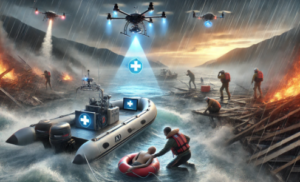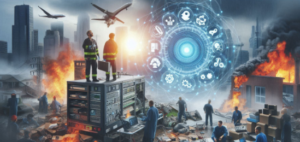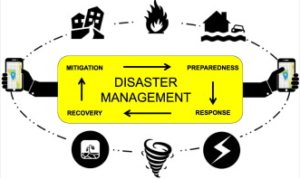
Disaster Management and Response Technology
In a time of fast technology development, the inclusion of creative ideas into disaster management and response becomes ever more important. The way we plan for, react to, and rebuild from disasters is being transformed by technology, as this paper investigates. From early warning systems to the use of artificial intelligence (AI) and drones, technology is becoming important in improving the efficiency and efficacy of disaster management activities.
Introductions
Natural and man-made disasters alike can strike with little notice, wreaking great damage and counting many people affected. Under such circumstances, quick and strong reaction is absolutely vital to minimize damage and save lives. Fortunately, technological developments have given fresh instruments and approaches to enhance disaster control. Examining their uses, advantages, and difficulties, this paper explores the several technology advancements changing catastrophe response and management.
Systems of Early Warnings
Early Warning Systems: Their Function
Early warning systems are meant to provide people time to get ready and respond suitably by offering advance notification of approaching disasters. Using technology to forecast and warn people about natural catastrophes including hurricanes, earthquakes, and tsunamis, these systemsa pillar of modern disaster managementalso reflect technology.
Meteorological satellites
Early warning systems depend much on meteorological satellites. These satellites help meteorologists track severe storms and give early warnings by offering real-time data on weather trends. Advanced sensors aboard satellites, for instance, enable them to sense variations in temperature and air pressure, thereby guiding the prediction of typhoons and hurricanes before they reach land.
Sensors for Seismic Detection
Monitoring and forecasting earthquakes depend much on seismic sensors. These sensors send data to monitoring centers after identifying the vibrations brought on by seismic events. Alerts can be sent to advise residents in impacted areas upon an earthquake’s detection. Furthermore, seismic data enables one to evaluate the possible influence of the earthquake, therefore facilitating improved preparedness and reaction.
Geographic Information Systems (GIS)
GIS stands for: what?
Powerful instruments for spatial data analysis and visualizing are Geographic Information Systems (GIS). GIS offers a whole picture of impacted areas in disaster management, therefore guiding responders toward wise decisions grounded on geographic knowledge.
Analysis and Maps
Detailed maps displaying several kinds of data, including population density, infrastructure, and hazard zones, made possible by GIS technologies show These maps help one find the most susceptible places and create escape routes during a disaster. GIS can map flood zones, for example, to identify which places are vulnerable and hence direct response activities.
Integrated Real-Time Data
The capacity of GIS to combine real-time data from several sources is among its main benefits. This covers ground sensor data, drone and satellite information. Combining different data sources lets GIS show a dynamic and current picture of the crisis scenario, therefore facilitating more efficient coordination and resource allocation.
Unmanned aerial vehicles (UAVs) and drones
Drone Rising in Disaster Response
In disaster response, drones also known as unmanned aerial vehicles have grown to be rather helpful instruments. Their capacity to compile data from difficult-to-reach locations and record aerial images makes them indispensable for damage assessment and relief planning.
Aerial Studies and Damage Evaluation
High-end cameras on drones enable aerial surveys to evaluate damage following an earthquake. In places dangerous or unreachable for human responders, this is especially helpful. For instance, drones were utilized extensively during natural events like hurricanes and earthquakes to offer real-time images of impacted areas, therefore guiding rescue efforts and efficient allocation of resources.

Operations of Search and Rescue
Rapidly covering vast distances, drones can find risks and locate survivors in search and rescue efforts. Thermal imaging cameras on some drones help to detect body heat, therefore facilitating the search for people buried in distant locations or caught in debris.
Machinelearning and artificial intelligence (AI)
Predictive analytics with artificial intelligence
Predictive analytics enabled by artificial intelligence (AI) and machine learning are revolutionizing disaster response. Analyzing enormous volumes of data, AI systems may find trends and project future events. Machine learning models, for instance, can examine weather data to forecast flooding or extreme storms.
Systems for Supporting Decision Making
Decision support systems driven by artificial intelligence help catastrophe managers to make wise decisions. To offer practical insights, these systems examine data from many sources—including social media, historical records, and weather forecasts. AI can, for example, prioritize evacuation orders by examining population density, infrastructure, and storm expected course.
Improving Coordination and Communication
Additionally helping response teams with communication and coordination is artificial intelligence. Virtual assistants and chatbots can connect consumers to emergency services, answer queries, and give real-time public information. Furthermore, AI-driven systems can help several agencies and companies to cooperate, therefore guaranteeing a better coordinated response.
Social Media and Crowdsourced Work
Social Media’s Function:
Disaster management now depends critically on social media. During a disaster, platforms including Twitter, Facebook, and Instagram offer real-time updates and act as a knowledge base. Alerts, safety guidelines, and missing person information can all be shared using social media.
Crowdsourcing for Disaster Response
Often via social media channels, crowdsourcing is the process of compiling data from many individuals to support disaster response. For instance, volunteers might use crowdsourcing tools to document damage, pinpoint hazards, and organize relief operations after big events. This collective information improves situational awareness and complements official statistics.
Obstacles and Issues and Thoughtfulness
Social media and crowdsourcing have problems even if they have many advantages. Rumors and false information can travel rapidly, perhaps causing panic and uncertainty. To stop the dissemination of misleading information, disaster management must confirm facts and express themselves precisely.
Mobile Technology and Apps
System of Emergency Alerts
Emergency warnings are now distributed thanks in great part to mobile technology. Emergency alert apps on smartphones allow them to get signals on approaching calamities, evacuation orders, and safety guidelines. These tools guarantee that people are educated and ready since they offer a direct and quick approach for public communication.

Apps for Maps and Navigation
Disaster response and recovery depend much on navigation and mapping tools. These programs offer alternatives, real-time traffic data, and road status updates as well as Navigating apps can assist people during evacuations in locating the fastest and safest paths to safe havens or shelters.
Safety Applications for Health
Apps for health and safety are great tools for managing health both before and following a crisis. These programs can offer details on mental health support, first aid, and medical service access. Certain apps also let users record health issues and ask for help, therefore enhancing access to treatment during an emergency.
Robotics and Automation
Robotic Rescue and Search
Emerging in disaster management, robotics is the discipline where robots meant for search and rescue activities find application. To find and help survivors, these robots can negotiate dangerous surroundings such as wrecked buildings or polluted locations. Having cameras and sensors, robotic devices can send real-time data to rescue teams, therefore improving their capacity for response.
Resource Management Automated Systems
Disaster resource management involves automation in some extent. Automated systems can control inventories, monitor supply availability, and best allocate resources. This guarantees that support gets to impacted communities quickly and effectively.
Cybersecurity and Data Management:
The Value of Data Organization
Disaster response calls for efficient data handling. To guide decisions, data from many sources including sensors, drones, and social media must be gathered, compiled, and examined. For disaster response teams, data management solutions offer insightful analysis and help arrange and handle this data.
Online Security Issues
Cybersecurity issues grow as technology permeates disaster response more and more. Maintaining the integrity of disaster response activities depends critically on safeguarding private information and guaranteeing the security of communication networks. Data breaches and cyberattacks can affect response activities and impede efforts at recovery.
Case Notes
First case study: Hurricane Harvey.
Disaster management during Hurricane Harvey in 2017 was substantially aided by technology. While GIS technology mapped flood areas and evaluated damage, meteorological satellites offered real-time data on the evolution of the storm. Aerial imagery of impacted areas was gathered using drones, therefore supporting damage assessment and recovery planning. Information was shared and volunteer activities were coordinated thanks in great part on social media sites.
Case Study 2: the 2011 Japan Earthquake and Tsunami
The 2011 Japan earthquake and tsunami brought real-time data integration and early warning systems’ significance to front stage. Early warnings of the earthquake came from seismic sensors; GIS technology mapped the tsunami’s effects. Search and rescue missions used drones and robotics; artificial intelligence-powered analytics assisted forecast disaster aftermath.
Prospective Patterns and Advancements
Developments in Technology
Disaster management’s future probably will see further technological innovation. More complex artificial intelligence algorithms, improved drone capabilities, and data integration and analysis advances define emerging trends. Furthermore integrating augmented reality (AR) and virtual reality (VR) could offer fresh instruments for simulation and training.
Cooperation and invention
Driving innovation in disaster response will depend critically on cooperation among research institutions, disaster response organizations, and technology providers. Working together, these organizations may create and apply innovative technologies improving response, recovery, and readiness.
Last Thought
Unquestionably, technology has changed disaster response and management by offering useful tools and approaches to raise effectiveness and efficiency. From early warning systems and GIS to drones and artificial intelligence, these developments greatly improve our capacity to ready for and react to calamities. Technology is always changing; we must be alert and flexible, using fresh developments to create a society more resilient and ready. Accepting technological advancements and encouraging teamwork would help us to protect areas and lessen the effects of next calamities.